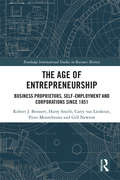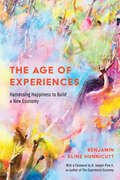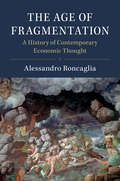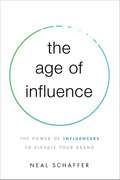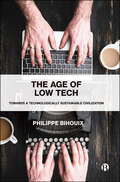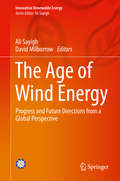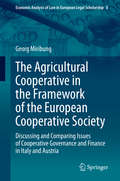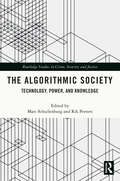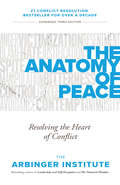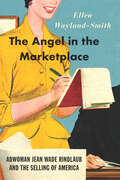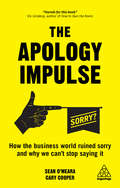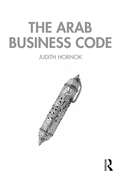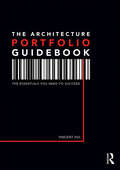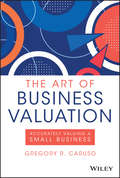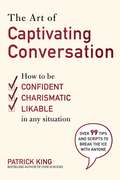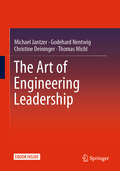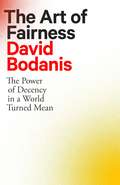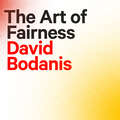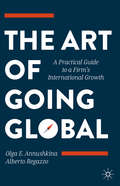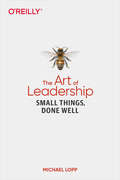- Table View
- List View
The Age of Entrepreneurship: Business Proprietors, Self-employment and Corporations Since 1851 (Routledge International Studies in Business History)
by Harry Smith Robert J. Bennett Carry van Lieshout Piero Montebruno Gill NewtonThis landmark research volume provides the first detailed history of entrepreneurship in Britain from the nineteenth century to the present. Using a remarkable new database of more than nine million entrepreneurs, it gives new understanding to the development of Britain as the world’s ‘first industrial nation’. Based on the first long-term whole-population analysis of British small business, it uses novel methods to identify from the 10-yearly population census the two to four million people per year who operated businesses in the period 1851–1911. Using big data analytics, it reveals how British businesses evolved over time, supplementing the census-derived data on individuals with other sources on companies and business histories. By comparing to modern data, it reveals how the late-Victorian period was a ‘golden age’ for smaller and medium-sized business, driven by family firms, the accelerating participation of women and the increasing use of incorporation as significant vehicles for development. A unique resource and citation for future research on entrepreneurship, of crucial significance to economic development policies for small business around the world, and above all the key entry point for researchers to the database which is deposited at the UK Data Archive, this major publication will change our understanding of the scale and economic significance of small businesses in the nineteenth century.
The Age of Experiences: Harnessing Happiness to Build a New Economy
by Benjamin HunnicuttIn The Age of Experiences, Benjamin Kline Hunnicutt examines how the advance of happiness science is impacting the economy, making possible new experience-products that really make people happy and help forward-looking businesses expand and develop new technologies. In today’s marketplace there is less interest in goods and services and more interest in buying and selling personal improvements and experiences. Hunnicutt traces how this historical shift in consumption to the “softer” technologies of happiness represents not only a change in the modern understanding of progress, but also a practical, economic transformation, profoundly shaping our work and the ordering of our life goals. Based on incisive historical research, Hunnicutt demonstrates that we have begun to turn from material wealth to focus on the enrichment of our personal and social lives. The Age of Experiences shows how industry, technology, and the general public are just beginning to realize the potential of the new economy. Exploring the broader implications of this historical shift, Hunnicutt concludes that the new demand for experiences will result in the reduction of work time, the growth of jobs, and the regeneration of virtue—altogether an increasingly healthy public life.
The Age of Fentanyl: Ending the Opioid Epidemic
by Brodie RaminIs there a way to end North America’s opioid epidemic? In The Age of Fentanyl, Brodie Ramin tells the story of the opioid crisis, showing us the disease and cure from his perspective as an addiction doctor working on the front lines. We meet his patients, hear from other addiction experts, and learn about the science and medicine of opioid addiction and its treatments. He shows us how addiction can be prevented, how knowledge can reduce stigma, and how epidemics can be beaten. Dr. Ramin brings the hopeful message that just as patients and health care workers rallied together to fight HIV one generation ago, a coalition of patients, advocates, scientists, doctors, and nurses is once again finding solutions and making plans to stem the overdose deaths, block the spread of fentanyl, and end the epidemic.
The Age of Fragmentation: A History of Contemporary Economic Thought
by Alessandro RoncagliaThe field of economics has proliferated in complexity and importance since the Second World War. Alessandro Roncaglia recounts the history of the different approaches (marginalist, neoclassical, Keynesian, Austrian, monetarism, rational expectations, institutionalist, evolutionary, classical-Sraffian) and the different fields (micro, macro, money and finance, industrial and game theory, institutions, public finance, econometrics), illustrating the thought and personality of the most important contemporary economists (from Hayek to Sraffa, from Modigliani and Samuelson to Friedman, from Simon to Sen, and many others), focusing on the conceptual foundations of the different streams. At the same time he appraises critically the important debates and controversies in the field and concludes by discussing possible future directions for economic thought. This follow-up to The Wealth of Ideas: A History of Contemporary Economic Thought is a readable introduction to the contemporary economics discourse, accessible to economics students and informed general readers, and an important complement for advanced students and economists active in specialized fields.
The Age of Influence: The Power of Influencers to Elevate Your Brand
by Neal SchafferThe Age of Influence is an essential guide for marketing professionals and business owners who want to create and implement a highly effective, sustainable influencer marketing plan in order for their brands to succeed.We are amid an unprecedented digital transformation and tapping into this change is vital to any brand in today&’s climate. Social media has democratized authority and influence, and information is created and consumed in ways that are constantly evolving.Internationally-recognized social media marketing expert Neal Schaffer explains how that shift plays a significant role in online marketing in the Influencer Era. Influencer marketing is about establishing relationships, turning fans into influencers, and leveraging that influence to share your message in a credible and authentic way.In The Age of Influence, Schaffer teaches entrepreneurs, marketing executives, and cutting-edge agencies how to:Identify,?approach, and engage the right influencers for their brand or product.Determine?what resources to put behind influencer campaigns.Manage the business side of influencer marketing, including tools that will help?measure ROI.Develop?their brand&’s social media voice to become an influencer in its own right.This book is the definitive guide to addressing the issues disrupting marketing trends, including declining television viewership, growing social media audiences, effectively spreading their message digitally, and increasing usage of ad-blocking technology.
The Age of Low Tech: Towards a Technologically Sustainable Civilization
by Philippe BihouixPeople often believe that we can overcome the profound environmental and climate crises we face by smart systems, green innovations and more recycling. However, the quest for complex technological solutions, which rely on increasingly exotic and scarce materials, makes this unlikely. A best-seller in France, this English language edition introduces readers to an alternative perspective on how we should be marshalling our resources to preserve the planet and secure our future. Bihouix skilfully goes against the grain to argue that ‘high’ technology will not solve global problems and envisages a different approach to build a more resilient and sustainable society.
The Age of Wind Energy: Progress and Future Directions from a Global Perspective (Innovative Renewable Energy)
by Ali Sayigh David MilborrowThis unique volume on wind energy features contributions from the world’s leading research and development pioneers in the field of renewable energy. It discusses advances in offshore wind technology, grid-connected systems, grid stabilization and wind turbine design and highlights. Written from an international perspective, chapters focus on the status of wind energy in various regions and countries across the globe, outlining the positive impact its implementation has had on delaying the catastrophic effects of climate change.
The Agricultural Cooperative in the Framework of the European Cooperative Society: Discussing and Comparing Issues of Cooperative Governance and Finance in Italy and Austria (Economic Analysis of Law in European Legal Scholarship #8)
by Georg MiribungThis book assesses the Statute for a European Cooperative Society (SCE) regarding agricultural activities by comparing how specific questions arising in this context must be dealt with under the Italian and Austrian legal systems. In this regard, Council Regulation (EC) No. 1435/2003, of 22 July 2003, on the Statute for a European Cooperative Society (SCE), is used as a tool for the structured analysis of various aspects of agricultural cooperatives. However, a comparison is only meaningful if the results are made comparable on the basis of a previously defined standard. Accordingly, the study uses, on one hand, a cooperative model developed by European legal scholars that defines general guidelines on how cooperatives should function (PECOL). On the other, the results are presented in connection with economic considerations to discuss how efficient rules can be developed.
The Akamai Technical Academy
by Lynda M. Applegate James BarnettIn January 2020, Akamai Technologies leadership considers next steps for the Akamai Technical Academy, a program that trained individuals without a traditional STEM degree for technically oriented jobs at Akamai.
The Algorithmic Society: Technology, Power, and Knowledge (Routledge Studies in Crime, Security and Justice)
by Marc Schuilenburg Rik PeetersWe live in an algorithmic society. Algorithms have become the main mediator through which power is enacted in our society. This book brings together three academic fields – Public Administration, Criminal Justice and Urban Governance – into a single conceptual framework, and offers a broad cultural-political analysis, addressing critical and ethical issues of algorithms. Governments are increasingly turning towards algorithms to predict criminality, deliver public services, allocate resources, and calculate recidivism rates. Mind-boggling amounts of data regarding our daily actions are analysed to make decisions that manage, control, and nudge our behaviour in everyday life. The contributions in this book offer a broad analysis of the mechanisms and social implications of algorithmic governance. Reporting from the cutting edge of scientific research, the result is illuminating and useful for understanding the relations between algorithms and power.Topics covered include: Algorithmic governmentality Transparency and accountability Fairness in criminal justice and predictive policing Principles of good digital administration Artificial Intelligence (AI) in the smart city This book is essential reading for students and scholars of Sociology, Criminology, Public Administration, Political Sciences, and Cultural Theory interested in the integration of algorithms into the governance of society.
The Anatomy of Peace: Resolving the Heart of Conflict (Bk Life Ser.)
by The Arbinger InstituteFrom the authors of Leadership and Self-Deception, which sold over 2 million copies, this new edition explores how we misunderstand the causes of our conflicts and shows us the paths to achieving true peace within ourselves, in our relationships, and even between nations. In this day and age, perhaps there is nothing more important than knowing how to heal relationships that are breaking and how to maintain connections when people are pulling apart. So many of our conflicts seem unsolvable, but what if conflicts at home, at work, and in the world stem from the same root cause? What if we systematically misunderstand that cause? And what if, as a result, we unwittingly perpetuate the very problems we think we are trying to solve?This book unfolds as a story. Yusuf al-Falah, an Arab, and Avi Rozen, a Jew, each lost his father at the hands of each other's cousins. The Anatomy of Peace is the story of how they come together, how they help their warring parents and children come together, and how we too can find our way out of the personal, professional, and global conflicts that weigh us down. This expanded third edition includes diagrams and discussions that further explain some of the book's approaches, current research about key ideas, and how the transformation approach in the book relates to Arbinger's comprehensive organizational mindset-change process.
The Angel in the Marketplace: Adwoman Jean Wade Rindlaub and the Selling of America
by Ellen Wayland-SmithThe popular image of a midcentury adwoman is of a feisty girl beating men at their own game, a female Horatio Alger protagonist battling her way through the sexist workplace. But before the fictional rise of Peggy Olson or the real-life stories of Patricia Tierney and Jane Maas came Jean Wade Rindlaub: a female power broker who used her considerable success in the workplace to encourage other women—to stick to their kitchens. The Angel in the Marketplace is the story of one of America’s most accomplished advertising executives. It is also the story of how advertisers like Rindlaub sold a postwar American dream of capitalism and a Christian corporate order. Rindlaub was responsible for award-winning, mega sales-generating advertisements for all things domestic, including Oneida silverware, Betty Crocker cake mix, Campbell’s soup, and Chiquita bananas. Her success largely came from embracing, rather than subverting, the cultural expectations of women. She believed her responsibility as an advertiser was not to spring women from their trap, but to make that trap more comfortable. Rindlaub wasn’t just selling silverware and cakes; she was selling the virtues of free enterprise. By following the arc of Rindlaub’s career from the 1920s through the 1960s, we witness how a range of cultural narratives—advertising chief among them—worked powerfully to shape women’s emotional and economic behavior in support of the free market system. Alongside Rindlaub’s story, Ellen Wayland-Smith provides a riveting history of how women were repeatedly sold the idea that their role as housewives was more powerful, and more patriotic, than any outside the home. And by buying into the image of morality through an unregulated market, many of these women helped fuel backlash against economic regulation and socialization efforts throughout the twentieth century. The Angel in the Marketplace is a nuanced portrayal of a complex woman, one who both shaped and reflected the complicated cultural, political, and religious forces defining femininity in America at mid-century. This compelling account of one of advertising’s most fervent believers is a tale of a Mad Woman we haven’t been told.
The Apology Impulse: How the Business World Ruined Sorry and Why We Can’t Stop Saying It
by Cary Cooper Sean O'MearaSaying sorry is in crisis. On one hand there are anxious PR aficionados and social media teams dishing out apologies with alarming frequency. On the other there are people and organizations who have done truly terrible things issuing much-delayed statements of mild regret. We have become addicted to apologies but immune from saying sorry. In January 2018 there were 35 public apologies from high-profile organizations and individuals. That's more than one per day. Between them, in 2017, the likes of Facebook, Mercedes Benz and United Airlines issued over 2,000 words of apologies for their transgressions. Alarmingly, the word 'sorry' didn't appear once. This perfectly timed book examines the psychology, motivations and even the economic rationale of giving an apology in the age of outrage culture and on-demand contrition. It reveals the tricks and techniques we all use to evade, reframe and divert from what we did and demonstrates how professionals do it best. Providing lessons for businesses and organizations, you'll find out how to give meaningful apologies and know when to say sorry, or not say it at all. The Apology Impulse is the perfect playbook for anyone - from social media executive through to online influencers and CEOs - who apologise way too much and say sorry far too infrequently.
The Arab Business Code
by Judith HornokThe Gulf Cooperation Council (GCC) countries are some of the richest and most dynamic emerging markets in the world. But they are tough markets! International companies must think seriously if they want to do business there – the barriers can be numerous and difficult. But the opportunities are phenomenal and rewarding. The key to success is to plan and take the right steps. This book shows how to do this by decoding, using case studies, and suggesting relevant solutions. For Judith Hornok, it’s not about dry theories or mind games. Instead this book is based on numerous case studies drawn from the lives of well-known Arab and international business people. The reader can grasp the opportunities and avoid the pitfalls by knowing and understanding the Arab Business Code (ABC): "learning the A-B-Cs." This book offers a study with practical measures, a toolkit of easy-to-learn and simple-to-use techniques that pave the way for business success in the Gulf. Over fifteen years of research is boiled down into a clearly structured, compact book. Judith Hornok presents the insights of her studies by decoding the behavior of Arab business people in the Gulf using innovative techniques and new approaches, which can be easily implemented by the reader. For the first time Judith also presents her creations – the figures of The Seven Emotional Hinderers.
The Architecture Portfolio Guidebook: The Essentials You Need to Succeed
by Vincent HuiThe Architecture Portfolio Guidebook shows you how to make portfolios for both academic and professional needs to provide reviewers exactly what they are looking for. In school, architecture curricula nurture the knowledge and skills to develop design work to varying levels of presentation. In the profession, those skills are further developed and applied in the creation of the built environment. In both contexts, a portfolio is a core component for admission and advancement. This book provides key strategies to: • develop an understanding of the unique needs of professional and academic organizations; • identify applicants’ key differentiators; • highlight how applicants present themselves in their portfolios to address institutional needs; • create successful reinforcing documentation; • communicate using portfolios. Rather than proposing generic solutions, this book details the successful practices for portfolio creation by addressing portfolio creation academically and professionally. Supporting insights and examples from leading academics and architects from around the world reinforce the themes presented in this guidebook. An ideal read for students and professionals of architecture, landscape architecture, interior design, and urban design, looking to advance their studies and careers.
The Architecture of Full-Scale Mock-Ups: From Representation to Reality
by Nick GelpiThe Architecture of Full-Scale Mock-Ups looks at the theory and contemporary practice of creating full-scale architectural mock-ups. This book serves as an introduction to the various forms of full-scale mock-ups which occur today. To broaden the definition of mock-ups, Nick Gelpi dives deep into the use of mock-ups in seven high-profile and global contemporary case studies. Instead of the presentation drawings and final building photos, the documentation of case studies relies on process photos, interviews, and moments of tension in the execution of each building. With never-before-published content, case studies include buildings from all over the world, including the Quincho Tia Coral and Teleton Building, Copper House II, the Pérez Art Museum Miami, the Cité de l’Océan et du Surf Museum, and more. Investigating unique case studies to answer how and when full-scale mock-ups occur today, this book is ideal for professionals and students of architecture studying materials and representation, design-build, and professional practice.
The Architecture of Natural Cooling
by Brian Ford Rosa Schiano-Phan Juan A. VallejoOverheating in buildings is commonplace. This book describes how we can keep cool without conventional air-conditioning: improving comfort and productivity while reducing energy costs and carbon emissions. It provides architects, engineers and policy makers with a ‘how-to’ guide to the application of natural cooling in new and existing buildings. It demonstrates, through reference to numerous examples, that natural cooling is viable in most climates around the world. This completely revised and expanded second edition includes: An overview of natural cooling past and present. Guidance on the principles and strategies that can be adopted. A review of the applicability of different strategies. Explanation of simplified tools for performance assessment. A review of components and controls. A detailed evaluation of case studies from the USA, Europe, India and China. This book is not just for the technical specialist, as it also provides a general grounding in how to avoid or minimise air-conditioning. Importantly, it demonstrates that understanding our environment, rather than fighting it, will help us to live sustainably in our rapidly warming world.
The Art of Business Valuation: Accurately Valuing a Small Business
by Gregory R. CarusoStarting from the practical viewpoint of, “I would rather be approximately right than perfectly wrong” this book provides a commonsense comprehensive framework for small business valuation that offers solutions to common problems faced by valuators and consultants both in performing valuations and providing ancillary advisory services to business owners, sellers, and buyers. If you conduct small business valuations, you may be seeking guidance on topics and problems specific to your work. Focus on What Matters: A Different Way of Valuing a Small Business fills a previous void in valuation resources. It provides a practical and comprehensive framework for small and very small business valuation (Companies under $10 million of revenues and often under $5 million of revenues), with a specialized focus on the topics and problems that confront valuators of these businesses. Larger businesses typically have at least Reviewed Accrual Accounting statements as a valuation starting point. However, smaller businesses rarely have properly reviewed and updated financials. Focus on What Matters looks at the issue of less reliable data, which affects every part of the business valuation. You’ll find valuation solutions for facing this challenge. As a small business valuator, you can get direction on working with financial statements of lower quality. You can also consider answers to key questions as you explore how to value each small business. Is this a small business or a job? How much research and documentation do you need to comply with standards? How can you use cash basis statements when businesses have large receivables and poor cutoffs? Should you use the market method or income method of valuation? Techniques that improve reliability of the market method multiplier How might you tax affect using the income method with the advent of the Estate of Jones and Section 199A? Do you have to provide an opinion of value or will a calculation work? How do you calculate personal goodwill? As a valuation professional how can you bring value to owners and buyers preparing to enter into a business sale transaction? How does the SBA loan process work and why is it essential to current small business values? What is the business brokerage or sale process and how does it work? How do owners increase business value prior to a business sale? This book examines these and other questions you may encounter in your valuation process. You’ll also find helpful solutions to common issues that arise when a small business is valued.
The Art of Captivating Conversation: How to Be Confident, Charismatic, and Likable in Any Situation
by King PatrickThe Art of Captivating Conversation is a book for enhancing social skills and developing conversation starters—how to have a deeper connection with people, with tips based on human and social psychology as well as the author's observations and proven coaching techniques. Readers will learn the basics of what makes a good interaction, as well as a plethora of highly-actionable techniques to become more confident, charismatic, and likable.
The Art of Engineering Leadership: Compelling Concepts and Successful Practice
by Thomas Michl Michael Jantzer Godehard Nentwig Christine DeiningerIn times of networking and the growing importance of platform economies, how can products and services be developed that inspire people? Which development methods and organisational forms are promising for this? Leaders and developers will find answers to these questions in this book. With their holistic approach, the authors look at the changing leadership roles that arise in the development of products and services: Is it, for example, about translating new ideas or unknown technologies into high-quality products? Or is it about working efficiently together in an international development alliance? The procedures and models were discussed and further developed in more than 10,000 theoretical and practical workshops with managers at Bosch worldwide. At its core is a leadership model that facilitates discussion and combines the skills needed to master technical issues with those needed to lead people.After an introductory chapter on fundamental questions such as the organization's purpose, values, and strategic goals, key elements of leadership in systems design are introduced, including requirements engineering, architecture design, and model-based development. The following chapters discuss concrete approaches and strategies to- Convert quality attributes,- to reduce risks,- to introduce a review culture, - manage complexity- Process conflicts- Define roles- to build teams.The structure of the book follows the process of developing and implementing strategic goals. However, each chapter can also be read on its own, as it forms a self-contained unit.This book makes the leadership task understandable, discussable and learnable for developers. It thus helps managers to shape change in their own field of work or to grow into a new role.
The Art of Fairness: The Power of Decency in a World Turned Mean
by David Bodanis'David Bodanis is an enthralling storyteller. Prepare to be taken on a surprising, wide-ranging and ultimately inspiring journey to explore what makes us human' Tim HarfordCan you succeed without being a terrible person? We often think not: recognising that, as the old saying has it, 'nice guys finish last'. But does that mean you have to go to the other extreme, and be a bully or Machiavellian to get anything done?In THE ART OF FAIRNESS, David Bodanis uses thrilling historical case studies to show there's a better path, leading neatly in between. He reveals how it was fairness, applied with skill, that led the Empire State Building to be constructed in barely a year - and how the same techniques brought a quiet English debutante to become an acclaimed jungle guerrilla fighter. In ten vivid profiles - featuring pilots, presidents, and even the producer of Game of Thrones - we see that the path to greatness doesn't require crushing displays of power or tyrannical ego. Simple fair decency can prevail.With surprising insights from across history - including the downfall of the very man who popularised the phrase 'nice guys finish last' - THE ART OF FAIRNESS charts a refreshing and sustainable new approach to cultivating integrity and influence.
The Art of Fairness: The Power of Decency in a World Turned Mean
by David Bodanis'David Bodanis is an enthralling storyteller. Prepare to be taken on a surprising, wide-ranging and ultimately inspiring journey to explore what makes us human' Tim HarfordCan you succeed without being a terrible person? We often think not: recognising that, as the old saying has it, 'nice guys finish last'. But does that mean you have to go to the other extreme, and be a bully or Machiavellian to get anything done?In THE ART OF FAIRNESS, David Bodanis uses thrilling historical case studies to show there's a better path, leading neatly in between. He reveals how it was fairness, applied with skill, that led the Empire State Building to be constructed in barely a year - and how the same techniques brought a quiet English debutante to become an acclaimed jungle guerrilla fighter. In ten vivid profiles - featuring pilots, presidents, and even the producer of Game of Thrones - we see that the path to greatness doesn't require crushing displays of power or tyrannical ego. Simple fair decency can prevail.With surprising insights from across history - including the downfall of the very man who popularised the phrase 'nice guys finish last' - THE ART OF FAIRNESS charts a refreshing and sustainable new approach to cultivating integrity and influence.
The Art of Going Global: A Practical Guide to a Firm's International Growth
by Olga E. Annushkina Alberto RegazzoInternationalizing your firm presents both exciting opportunities and daunting challenges, regardless of your industry. While strategy will vary from firm to firm, this book provides a solid set of decision-making tools that will support you as you take your company global. Starting with the most important step – cultivating a truly international perspective in your senior management team – it sets out the pros and cons of each choice you will face as you define and shape a global strategy. With a pragmatic toolkit provided at the end of each chapter, The Art of Going Global will help to improve your decision-making capabilities in relation to a range of challenges, including:· Selecting foreign markets · Adapting your business model· Navigating uncertain global markets· Managing across cultures· Choosing between entry mode options With case studies and insights illustrating how to apply each toolkit, this book is ideal for practitioners, MBA students, and those in executive education. It will help you to consider a variety of alternative solutions for key managerial decisions on internationalization, the costs and benefits of different strategic scenarios, and ultimately drive you to create a clear global vision for your firm.
The Art of Investigation
by Chelsea A. Binns Bruce SackmanThe Art of Investigation examines the qualities required to be a professional, thorough, and effective investigator. As the title suggests, it delves into more than the steps and procedures involved in managing an investigation, it also covers the "soft skills" necessary to effectively direct investigations and intuit along the way. The editors and contributing authors are the best in their field, and bring a wealth of real-world knowledge and experience to the subject. There are several publications available on the nuts-and-bolts of the process and stages of an investigation. That ground has been covered. However, little has been published on the investigative skills required, the traits necessary, and the qualities endemic to an inquisitive mind that can be cultivated to improve an investigator’s professional skill-set. Each chapter discusses the applicability of the traits to the contributor’s own work and experience as an investigator. In doing so, the contributors provide a story—or set of stories—from their personal experience, which demonstrates a given trait and its importance in the course of their investigative work and career. This will be first-hand experience that will serve to help any investigative professional in the course of their work. The case examples included throughout are sometimes surprising, but always engaging and insightful. An investigator must keep an open mind above all else, and this book will "lift the veil" on the inner workings of an investigation, in addition to the thought processes and inner monologues of an investigator as part of that process. Key Features • Chapters highlight the qualities and traits—the "soft skills"—that are required, and which can be improved over time, to be a thorough investigator. • A veritable "Who’s Who" of renowned investigative experts lend their personal expertise and experience to this how-to manual for investigators. • A unique approach is applied and provides self-help advice for both new and experienced investigative and security professionals. • The book focuses on the learned, acquired, and intuitive skills of investigation—a nuanced but essential aspect of the investigative skill-set. The Art of Investigation will be a welcome addition to any investigator’s toolkit and will also be of interest to students in criminal justice, security, and Homeland Security programs, security consultants, corporate and private security professionals, and the legal community.
The Art of Leadership: Small Things, Done Well
by Michael LoppMany people think leadership is a higher calling that resides exclusively with a select few who practice and preach big, complex leadership philosophies. But as this practical book reveals, what’s most important for leadership is principled consistency. Time and again, small things done well build trust and respect within a team.Using stories from his time at Netscape, Apple, and Slack, Michael Lopp presents a series of small but compelling practices to help you build leadership skills. You’ll learn how to create teams that are highly productive, highly respected, and highly trusted. Lopp has been speaking and writing about this topic for over a decade and now maintains a Slack leadership channel with over 13,000 members.The essays in this book examine the practical skills Lopp learned from exceptional leaders—as a manager at Netscape, a senior manager and director at Apple, and an executive at Slack. You’ll learn how to apply these lessons to your own experience.
